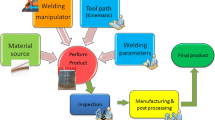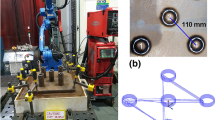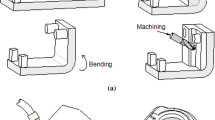Abstract
Integration of tube end forming operations in metal additive manufacturing routes has a great potential for the fabrication of customized features in additively deposited hollow parts. This paper is focused on the integration of tube expansion with rigid tapered conical mandrels to highlight the advantages in the construction of overhanging flares derived from the elimination of support structures and prevention of humping. The work draws from the mechanical and formability characterization of stainless steel AISI 316L tubes produced by wire arc additive manufacturing (WAAM) to the experimental and numerical simulation of the construction of overhanging flares by tube expansion. Strain loading paths obtained from digital image correlation and finite element analysis combined with the strain values at the onset of necking and fracture allow determining the critical ductile damage that additively deposited tubes can safely withstand. Results show that despite formability of additively deposited tubes being influenced by a dendritic based microstructure, their performance is adequate for tube end forming operations, such as tube expansion, to be successfully integrated in metal additive manufacturing without the need of using expensive hardware and complex deposition strategies.
Graphical abstract













Similar content being viewed by others
Data availability
Authors confirm that the data and material supporting the findings of this work are available within the article.
References
Jiang J, Xu X, Xiong Y, Tang Y, Dong G, Kim S (2020) A novel strategy for multi-part production in additive manufacturing. Int J Adv Manuf Technol 109:1237–1248. https://doi.org/10.1007/s00170-020-05734-8
Daniyan I, Mpofu K, Daniyan L, Fameso F, Oyesola M (2020) Computer aided simulation and performance evaluation of additive manufacturing technology for component parts manufacturing. Int J Adv Manuf Technol 107:4517–4530. https://doi.org/10.1007/s00170-020-05340-8
Lu X, Zhou YF, Xing XL, Shao LY, Yang QX, Gao SY (2017) Open-source wire and arc additive manufacturing system: formability, microstructures, and mechanical properties. Int J Adv Manuf Technol 93:2145–2154. https://doi.org/10.1007/s00170-017-0636-z
Pragana JP, Pombinha P, Duarte VR, Rodrigues TA, Oliveira JP, Bragança IM, Santos TG, Miranda RM, Coutinho L, Silva CM (2020) Influence of processing parameters on the density of 316L stainless steel parts manufactured through laser powder bed fusion Proceedings of the Institution of Mechanical Engineers, Part B. J Eng Manuf 234:1246–1257. https://doi.org/10.1177/0954405420911768
Murr LE, Martinez E, Amato KN, Gaytan SM, Hernandez J, Ramirez DA, Shindo PW, Medina F, Wicker RB (2012) Fabrication of metal and alloy components by additive manufacturing: examples of 3D materials science. Journal of Materials Research and technology 1:42–54. https://doi.org/10.1016/S2238-7854(12)70009-1
DebRoy T, Wei HL, Zuback JS, Mukherjee T, Elmer JW, Milewski JO, Beese AM, Wilson-Heid A, De A, Zhang W (2018) Additive manufacturing of metallic components–process, structure and properties. Prog Mater Sci 92:112–224. https://doi.org/10.1016/j.pmatsci.2017.10.001
Ford S, Despeisse M (2016) Additive manufacturing and sustainability: an exploratory study of the advantages and challenges. J Clean Prod 137:1573–1587. https://doi.org/10.1016/j.jclepro.2016.04.150
Lefky CS, Zucker B, Wright D, Nassar AR, Simpson TW, Hildreth OJ (2017) Dissolvable supports in powder bed fusion-printed stainless steel. 3D Printing and Additive Manufacturing 4:3–11. https://doi.org/10.1089/3dp.2016.0043
Ding Y, Dwivedi R, Kovacevic R (2017) Process planning for 8-axis robotized laser-based direct metal deposition system: a case on building revolved part. Robot Comput Integr Manuf 44:67–76. https://doi.org/10.1016/j.rcim.2016.08.008
Yuan L, Pan Z, Ding D, He F, van Duin S, Li H, Li W (2020) Investigation of humping phenomenon for the multi-directional robotic wire and arc additive manufacturing. Robot Comput Integr Manuf 63:101916. https://doi.org/10.1016/j.rcim.2019.101916
Kazanas P, Deherkar P, Almeida P, Lockett H, Williams S (2012) Fabrication of geometrical features using wire and arc additive manufacture. Proceedings of the Institution of Mechanical Engineers. Part B: Journal of Engineering Manufacture 226:1042–1051. https://doi.org/10.1177/0954405412437126
Yoon HS, Lee JY, Kim HS, Kim MS, Kim ES, Shin YJ, Chu WS, Ahn SH (2014) A comparison of energy consumption in bulk forming, subtractive, and additive processes: review and case study. International Journal of Precision Engineering and Manufacturing-Green Technology 1:261–279. https://doi.org/10.1007/s40684-014-0033-0
Seow CE, Coules HE, Wu G, Khan RH, Xu X, Williams S (2019) Wire arc additively manufactured Inconel 718: effect of post-deposition heat treatments on microstructure and tensile properties. Mater Des 183:108157. https://doi.org/10.1016/j.matdes.2019.108157
Woodcock J (2014) Euromold roundup - bigger, bolder, busier. TCT. http://www.tctmagazine.com/blogs/jwblog/euromold-roundup-2013/. Accessed 1 August 2020
Merklein M, Junker D, Schaub A, Neubauer F (2016) Hybrid additive manufacturing technologies–an analysis regarding potentials and applications. Phys Procedia 83:549–559. https://doi.org/10.1016/j.phpro.2016.08.057
Silva CMA, Bragança IMF, Cabrita A, Quintino L, Martins PAF (2017) Formability of a wire arc deposited aluminium alloy. J Braz Soc Mech Sci Eng 39:4059–4068. https://doi.org/10.1007/s40430-017-0864-z
Pragana JPM, Cristino VAM, Bragança IMF, Silva CMA, Martins PAF (2020) Integration of forming operations on hybrid additive manufacturing systems based on fusion welding. International Journal of Precision Engineering and Manufacturing-Green Technology 7:595–607. https://doi.org/10.1007/s40684-019-00152-y
Schulte R, Papke T, Lechner M, Merklein M (2020) Additive manufacturing of tailored blank for sheet-bulk metal forming processes. IOP Conf Ser Mater Sci Eng 967:12034
Rosenthal S, Platt S, Jager RH, Gies S, Kleszczynski S, Tekkaya AE, Witt G (2019) Forming properties of additively manufactured monolithic Hastelloy X sheets. Mater Sci Eng A 753:300–316. https://doi.org/10.1016/j.msea.2019.03.035
Ambrogio G, Gagliardi F, Muzzupappa M, Filice L (2019) Additive-incremental forming hybrid manufacturing technique to improve customised part performance. J Manuf Process 37:386–391. https://doi.org/10.1016/j.jmapro.2018.12.008
Baptista RJS, Pragana JPM, Bragança IMF, Silva CMA, Alves LM, Martins PAF (2020) Joining aluminium profiles to composite sheets by additive manufacturing and forming. J Mater Process Technol 279:116587. https://doi.org/10.1016/j.jmatprotec.2019.116587
Pragana JPM, Rosenthal S, Alexandrino P, Araújo A, Bragança IMF, Silva CMA, Leitão PJ, Tekkaya AE, Martins PAF (2021) Coin minting by additive manufacturing and forming. Proc Inst Mech Eng B J Eng Manuf 235:819–828. https://doi.org/10.1177/0954405420971128
Pragana JP, Rosenthal S, Bragança IM, Silva C, Tekkaya AE, Martins PA (2020) Hybrid additive manufacturing of collector coins. Journal of Manufacturing and Materials Processing 4:115. https://doi.org/10.3390/jmmp4040115
Bambach M, Sizova I, Sydow B, Hemes S, Meiners F (2020) Hybrid manufacturing of components from Ti-6Al-4V by metal forming and wire-arc additive manufacturing. J Mater Process Technol 282:116689. https://doi.org/10.1016/j.jmatprotec.2020.116689
Pragana JPM, Sampaio RFV, Bragança IMF, Silva CMA, Martins PAF (2021) Hybrid metal additive manufacturing: a state–of–the-art review. Advances in Industrial and Manufacturing Engineering 2:100032. https://doi.org/10.1016/j.aime.2021.100032
Almeida BPP, Alves ML, Rosa PAR, Brito AG, Martins PAF (2006) Expansion and reduction of thin-walled tubes using a die: experimental and theoretical investigation. Int J Mach Tools Manuf 46:1643–1652. https://doi.org/10.1016/j.ijmachtools.2005.08.018
Pragana JPM, Bragança IMF, Silva CMA, Martins PAF. 2021. Revisiting the ring hoop test in additively manufactured metal tubes. Journal of Strain Analysis in Engineering Design (submitted).
ASTM (2016) E8/E8M. Standard test methods for tension testing of metallic materials, ASTM International, West Conshohocken, USA
ASTM (2000) D2290-00. Standard test method for apparent hoop tensile strength of plastic or reinforced plastic pipe by split disk method, ASTM International, West Conshohocken, USA
Nielsen CV, Martins PAF (2021) Finite element simulation: a user’s perspective, In: Metal forming: formability, simulation and tool design. Academic Press, London. https://doi.org/10.1016/B978-0-323-85255-5.00011-X
Hill R (1948) A theory of yielding and plastic flow of anisotropic metals. Proceedings of the Royal Society of London (Series A). 193:281–297
McClintock FA (1968) A criterion for ductile fracture by the growth of holes. Journal of Applied Mechanics – Transactions ASME 35:363–371
Cristino VA, Magrinho JP, Centeno G, Silva MB, Martins PAF (2019) A digital image correlation based methodology to characterize formability in tube forming. The Journal of Strain Analysis for Engineering Design 54:139–148. https://doi.org/10.1177/0309324718823629
Martins PAF, Bay N, Tekkaya AE, Atkins AG (2014) Characterization of fracture loci in metal forming. Int J Mech Sci 83:112–123. https://doi.org/10.1016/j.ijmecsci.2014.04.003
Code availability
Not applicable.
Funding
The authors would like to acknowledge the support provided by Fundação para a Ciência e a Tecnologia of Portugal and IDMEC under LAETA- UIDB/50022/2020.
Author information
Authors and Affiliations
Contributions
Pragana JPM: Conceptualization, methodology, numerical modelling, experimentation, writing—editing. Bragança IMF: Conceptualization, investigation, methodology, visualization. Silva CMA: Conceptualization, investigation, methodology, visualization, supervision. Martins PAF: Conceptualization, funding acquisition, methodology, numerical modelling, supervision, writing—original draft.
Corresponding author
Ethics declarations
Ethics approval
The article follows the guidelines of the Committee on Publication Ethics (COPE) and involves no studies on human or animal subjects.
Consent to participate
Not applicable.
Consent for publication
Not applicable.
Competing interests
The authors declare no competing interests.
Additional information
Publisher’s note
Springer Nature remains neutral with regard to jurisdictional claims in published maps and institutional affiliations.
Rights and permissions
About this article
Cite this article
Pragana, J.P., Bragança, I.M., Silva, C.M. et al. Integration of tube end forming in wire arc additive manufacturing: An experimental and numerical investigation. Int J Adv Manuf Technol 117, 2715–2726 (2021). https://doi.org/10.1007/s00170-021-07868-9
Received:
Accepted:
Published:
Issue Date:
DOI: https://doi.org/10.1007/s00170-021-07868-9




